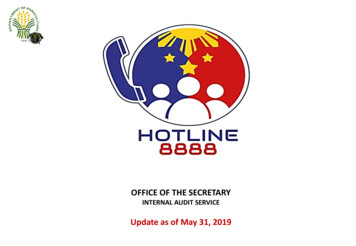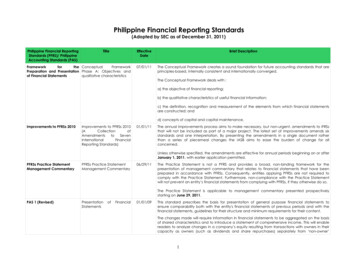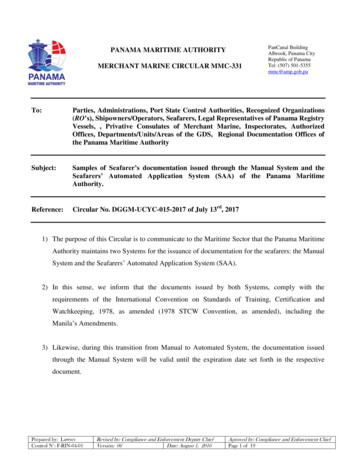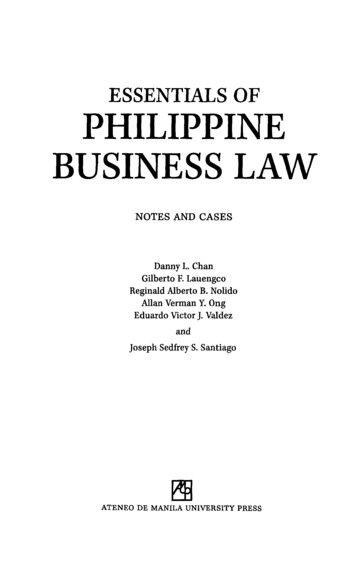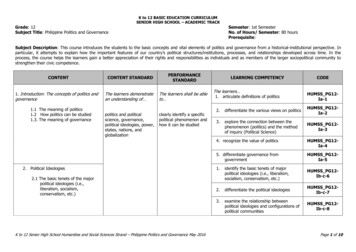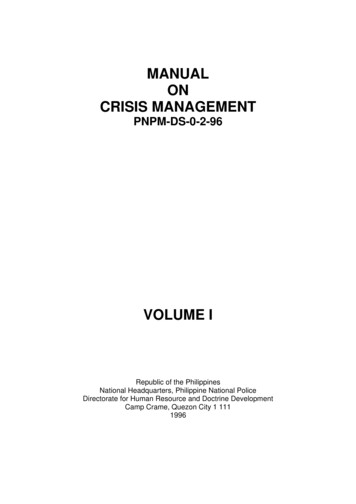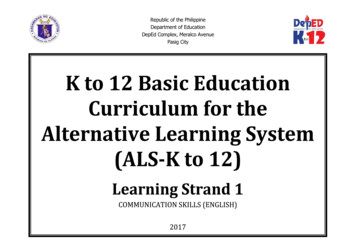
Transcription
Republic of the PhilippineDepartment of EducationDepEd Complex, Meralco AvenuePasig City
K TO 12 BASIC EDUCATION CURRICULUM FOR THE ALTERNATIVE LEARNING SYSTEM (ALS-K TO 12)LEARNING STRAND 1: COMMUNICATION SKILLS ENGLISHThe main thrust of Learning Strand (LS) 1 is Communication Skills, which seeks to develop the ability of out-of-school youth and adults to access,critically process, and effectively use available information in a variety of media so as to: function effectively as a member of the family, community, nation, and the world; andparticipate actively in community and economic development.Learning Strand 1 involves the five macro skills namely, listening purposively and critically; speaking clearly and appropriately; reading to processand critically use information from a wide range of written materials and other forms of media, expressing one’s ideas and feelings clearly and effectively inwriting, and viewing to demonstrate critical understanding and interpretation of visual media.This provides the framework of Learning Strand 1, which is schematically presented below.Learning Strand 1 Communication Skills (English)June 2017Page 2 of 51
K TO 12 BASIC EDUCATION CURRICULUM FOR THE ALTERNATIVE LEARNING SYSTEM (ALS-K TO 12)The content and performance standards, and competencies and skills in this Learning Strand are sequenced from the simplest to the most complex.This is intended to provide the learners opportunities to experience success in developing their ability to access, critically process, and effectively make use ofavailable information in a variety of media and express their ideas and feelings clearly and effectively in both oral and written forms. The gradual increase inscope and difficulty will help the learners develop self-confidence in using their communication skills at every level.When a certain competency is spiraled or assigned to more than one level in any of the five macro skills of English language learning, progression indifficulty may be achieved through the choice of learning materials for developing it. Considerations will be in terms of: type of materiallength of the materialchoice of words and language structureconcept loadThe Basic Literacy Level (BL) competencies is a separate section in the Enhanced ALS Curriculum focused only on Basic Level competencies onCommunication Skills (listening, speaking, viewing, reading, and writing) and numeracy.This section for Basic Literacy competencies is not a stand-alone, since specific concepts/topics from other Learning Strands will be used as contents forthe development of Basic Literacy skills.Note how this is illustrated in the example below:Performance Standard A, which focuses on the listening component of language learning, under Learning Competencies 6:Elementary Level(Lower):Show an understanding of most conversations in the language being acquired (understanding conversationscontaining some familiar and unfamiliar vocabulary).Elementary Level(Advanced):Show an understanding of most conversations in the language being acquired (understanding conversations torecount details).Junior High School:Show an understanding of most conversations in the language being acquired (understanding most conversationscontaining unfamiliar vocabulary but not necessarily all the details).Senior High School:Show an understanding of most conversations in the language being acquired (understanding conversations torecount accurately specific details).In this example, the learner is expected to show an understanding of conversations of gradually increasing difficulty. He/she starts withunderstanding conversations with phrases containing familiar vocabulary, progresses to understanding conversations containing some familiar and unfamiliarvocabulary, and later to a more complex understanding of most conversations containing unfamiliar vocabulary and accurately specific details in the languageLearning Strand 1 Communication Skills (English)June 2017Page 3 of 51
K TO 12 BASIC EDUCATION CURRICULUM FOR THE ALTERNATIVE LEARNING SYSTEM (ALS-K TO 12)being acquired.Progression in difficulty is also demonstrated below in Performance Standard B, which focuses on the speaking component of language learning,under Learning Competency 2.Elementary Level(Lower):Ask questions and correctly answer questions using W-H markers in responding to current issues and everydayinquiries.Elementary Level(Advanced):Ask questions and correctly answer questions related to current issues presented in the classroom and communityassemblies.Junior High School:Ask questions and correctly answer questions related to current issues presented in TV and radio programsencouraging audience participation.Senior High School:Ask questions and correctly answer questions related to current issues presented in TV and radio programs, theinternet, newspapers, magazines, books, billboard, video games, music, and all other forms of media.In this example, the degree of difficulty in the skill of questioning increases as the complexity and range of information to be gathered or inquiredabout increases.For Performance Standard C, which focuses on Reading, under Learning Competencies 12, 13, 14, and 16, the shift from easy to difficult is shown inthe following examples:Elementary Level(Lower):Elementary Level(Advanced):Junior High School:Senior High School:Interpret simple written sentences, e.g., sentences whose contents are related to: immediate needs specific activities in the community or workplaceInterpret complexly written sentences, e.g., sentences whose contents are related to: immediate needs specific activities in the community or workplace current goals urgent mattersInterpret the parts of important documents and forms when necessary, e.g., bio-data, application form, tax-relateddocuments, etc.Interpret themes and messages that are not clearly and explicitly stated in the passage, text or selection.In this particular example, the sequencing is achieved by gradually increasing the difficulty of the material or concept load from one level to another,specifically from simple common written messages, signs, symbols, words, and phrases to simple written sentences, to the interpretation of the parts ofimportant documents and forms, and finally to the interpretation of messages that are subtly expressed in passages, texts, or selections.Learning Strand 1 Communication Skills (English)June 2017Page 4 of 51
K TO 12 BASIC EDUCATION CURRICULUM FOR THE ALTERNATIVE LEARNING SYSTEM (ALS-K TO 12)For Performance Objective D, which concentrates on Writing, under Learning Competencies 11, 25, 26, and 27, examples are as follows:Elementary Level(Lower):Write simple, compound, and complex sentences on different activities, issues or occasions.Elementary Level(Advanced):Write simple paragraphs on different activities, issues, or occasions.Junior High School:Write well-organized, coherent, and grammatically correct paragraphs that talk about oneself, country, and theworld.Senior High School:Write a composition with correctly sequenced paragraphs using appropriate paragraph/sentence structure andcorrect grammar, punctuation, capitalization, and spelling to talk about oneself, country, and the world.In this example, complexity in skills increases from writing simple sentences simply to introduce oneself, to writing simple, compound, and complexsentences, to writing descriptive, narrative, expository, and persuasive paragraphs. This movement from easy to more difficult learning tasks will help thelearner to experience success in developing communication skills.For Performance Standard E, which concentrates on Viewing, examples are as follows:Elementary Level(Lower):Make connections between information viewed and personal experiences.(Competency #8)Elementary Level(Advanced):Determine images/ideas that are explicitly used to influence viewers (stereotypes) and interpret properly simplecommon written messages, signs, symbols, words, and phrases related to immediate needs or which arecommonly used at work or which are found in the community. (Competency # 19)Junior High School:Deduce the purpose and value of visual media to immediate needs or work.(Competency # 24)Senior High School:Demonstrate a critical understanding and interpretation of visual media such as movie clips, trailer, news flash,internet-based program, videos, documentaries, etc. (Competency # 24)In this example, viewing skill supports literacy in language and serves as gateway to exploring complex ideas and open learner’s eyes to other waysof looking at the world. Through it, multimedia resources can be used appropriately, efficiently, and effectively.There are objectives, competencies, and skills that are gradually being developed throughout the whole teaching-learning process in the threelevels—basic, elementary, and secondary—in the Alternative Learning System (ALS).Learning Strand 1 Communication Skills (English)June 2017Page 5 of 51
K TO 12 BASIC EDUCATION CURRICULUM FOR THE ALTERNATIVE LEARNING SYSTEM (ALS-K TO 12)Increase in difficulty in terms of the medium or stimulus, for instance, initial listening activity could be an informal face-to-face conversation, whichwould then progress to simple announcements and later to radio and television interviews/programs, will provide opportunities forthe learners to widentheexperience that would redound to the gradual development and attainment of the objectives, competencies, and skills as they progress through the threelearning levels.For that strategy to work, however, the curriculum usersshould consider the age level, experience, cultural context, and social milieu of the targetlearners. This is crucialto the process of developing or selecting learning materials, or perhapstoplanning activities for the conduct of regular or speciallearning group sessionsand other such pursuits that would help attain the objectives as naturally as possible. Take, for instance, Performance Standard A, 5,of Learning Strand 1, which is illustrated below.Elementary Level(Lower):Listen in order to recount accurately specific details of informative oral messages in conversations.Elementary Level(Advanced):Listen in order to recount some specific details of informative oral messages in formal and informal discussions.Junior High School:Listen in order to recount accurately specific details of informative oral messages in religious leaders’sermons/homilies/preachings.Senior High School:Listen in order to recount accurately specific details of informative oral messages in radio/TVprograms/speeches/advertisements.At the basic level, a stimulus such as a simple informal conversation, which usually takes place at home between and among family members, mayrequire not much concentration. It then progresses to a newscast—a more sophisticated medium, which requires greaterconcentration and focus at theelementary level. Finally, at the secondary level, the learners are taken to a larger environmental context, which increases their responsibility to fullyconcentrate and make use of more senses, and challenges their ability to critically analyze what has been seen, heard and observed, and viewed.SENIOR HIGH SCHOOLTo complete SHS and meet the competencies for the middle skills development, entrepreneurship, and employment exits of the basic educationcurriculum, ALS learners must complete the competencies that are specified in English for Academic and Professional Purposes and Practical Research 1 and2 (which are applied subjects). The topic of Practical Research 1 and 2 may be lifted from the other ALS learning strands. They should also complete thespecialization subjects of any of the following Senior High School tracks: Sports, Arts and Design or Technical-Vocational-Livelihood.College-bound ALS learners in SHS must also complete the core subjects Oral Communication, Reading and Writing and 21st Century Literature fromthe Philippines and the World (or their equivalents). They must also complete all the specialization subjects in any of the Academic Strands (Accountancy,Business and Management [ABM], Humanities and Social Sciences [HUMSS], Science, Technology, Engineering and Mathematics [STEM], or GeneralAcademic).If an ALS learner who has completed the K to 12 curriculum wishes to proceed to higher education, this learner may return to the ALS program andtake the core curriculum at any time.Learning Strand 1 Communication Skills (English)June 2017Page 6 of 51
K TO 12 BASIC EDUCATION CURRICULUM FOR THE ALTERNATIVE LEARNING SYSTEM (ALS-K TO 12)Learning Strand 1: Communication SkillsBASIC LITERACY LEVELContent Standard: ListeningPerformance Standard A:Listen attentively and critically in at least two languages to be able to function effectively as a member ofthe family, the community, the nation and the world and to participate in community and economicdevelopment.Learning CompetenciesCodeK to 12ALS1. Show understanding of simple phrases, spoken slowly with frequent repetitions in the language to beacquired in day-to-day listening occasions: ConversationsTelephone callsReligious leaders' sermons/homilies/preachingFormal and informal discussions of people on the streets, market place, etc.Radio and television programsRadio and television adsRadio and television interviews2. Show understanding of phrases containing familiar vocabulary in different contexts in the languagebeing acquired.3. Show understanding of conversations containing some familiar and unfamiliar vocabulary in thelanguage being acquired.4. Show understanding of most conversations in the language being acquired (not necessarily all thedetails if the subject is unfamiliar).5.Listen in order to recount accurately specific details of informative oral messages: ConversationsFormal and informal discussionsLearning Strand 1 Communication Skills (English)June e 7 of 51
K TO 12 BASIC EDUCATION CURRICULUM FOR THE ALTERNATIVE LEARNING SYSTEM (ALS-K TO 12)Learning Competencies CodeK to IVa-8.1LS1CS/EN-L-PSA-BL9Telephone callsReligious leader’s sermons/homilies/preachingAnnouncementsRadio and television ads6. Show understanding of oral messages: meant to inform, e.g., radio and TV programs, ads, newscasts;meant to entertain, e.g., talk shows, soap opera, movies; andmeant to give directions (Do-it-yourself-materials):- games- recipes- projects7. Show understanding and appreciation of conversation containing some familiar and unfamiliarvocabulary by: keeping eyes focused on the speaker, andresponding to what the speaker says and does through verbal and non-verbal cues.8. Show understanding of information from different oral sources: Newscast,Radio broadcastWeather forecast.9. Interpret verbal or nonverbal cues in conversation or oral presentations such as tone of voice, facialexpression or body language.10. Interpret properly auditory signals for warnings or ―survival‖ messages. Ringing of church bells, etc. concentrating on the person speakingLS1CS/EN-L-PSA-BL10Fire alarmTyphoon signals.11. Show understanding and respect for ideas and feelings of others by responding appropriately, e.g.,showing interest in others’ spoken opinionsLearning Strand 1 Communication Skills (English)June 2017EN7LC-IVa-8.1LS1CS/EN-L-PSA-BL11Page 8 of 51
K TO 12 BASIC EDUCATION CURRICULUM FOR THE ALTERNATIVE LEARNING SYSTEM (ALS-K TO 12)Learning Competencies interpreting correctly the meaning of a speaker’s tone of voice traveling to a destinationCodeK to 4LS1CS/EN-L-PSA-BL13interpreting what a speaker has said.12. Follow oral instructions/directions in everyday life situations such as:using organic fertilizers/compost makingselecting inexpensive but nutritious foodprotecting the environment (see Learning Strand II)using a recipe as a guide to food preparationperforming simple experiments (see LS II).13. Listen attentively and critically to radio and television broadcasts to keep abreast of currentissues/happenings in the world: family conflict (relationship among family members, inheritance)family planningLearning Strand 1 Communication Skills (English)June 2017Page 9 of 51
K TO 12 BASIC EDUCATION CURRICULUM FOR THE ALTERNATIVE LEARNING SYSTEM (ALS-K TO 12)Learning Strand 1: Communication SkillsBASIC LITERACY LEVELContent Standard: SpeakingPerformance Standard B:Speak clearly and appropriately in at least two languages to be able to function effectively as a memberof the family, community, nation and the world and to participate in community and economicdevelopment.Learning CompetenciesCodeK to 12ALS1. Use everyday expressions correctly in appropriate situations. Introductions- How do you do? Greetings- How are you?- Hi!- Hello! Leave-taking- Goodbye. May I leave for a while? May I leave now?Inviting someone- Will you join us, Ana? Please join us.Would you like some pressing apology.for hurting others’ feelings (I’m sorry that I’m sorry for )for the bad things done2. Use basic words accurately in the language to be acquired.Learning Strand 1 Communication Skills (English)June 2017LS1CS/EN-S-PSB-BL2Page 10 of 51
K TO 12 BASIC EDUCATION CURRICULUM FOR THE ALTERNATIVE LEARNING SYSTEM (ALS-K TO 12)Learning Competencies3. Ask and answer questions correctly.3.1 Ask questions using markers correctly, e.g., who, what, how, why.3.2 Ask questions related to everyday urgent inquiries, e.g., locating places and people, purchasingitems in the market3.3 Ask/answer questions related to current issues presented in: home/family discussions/conversations community assemblies TV/radio program encouraging audience participation3.4 Ask concise direct questions on familiar and some unfamiliar subjects3.5 Respond appropriately to questions in given situations e.g. everyday situations and activities e.g.economic-livelihood, socio cultural activities, health problems4. Respond appropriately to ideas and feelings of others through verbal and non-verbal means. CodeK to 4LS1CS/EN-S-PSB-BL3.5Nodding of one’s headSmiling, frowning and opening the eyes when surprisedRaising an eyebrowShowing concentration on the person -BL4Showing interest in others’ spoken opinionsInterpreting correctly the meaning of a speaker’s tone of voiceParaphrasing what a speaker has said5. Use basic grammar correctly in the language being acquired. e.g.: On conflict and violence―Violent video games are not good for children.‖―There are many things that can cause conflict or anxiety.‖―A non-violent solution is the best course of action.‖ On environmental care and sanitation―Communities should attempt to recycle as much trash as possible.‖―Recycling alone cannot solve the growing waste problem.‖―Eliminating use of styrofoam in food packaging is a good practice.‖ On recreation―My brother and I are going to a movie tonight.‖ LS1CS/EN-S-PSB-BL5On election issuesLearning Strand 1 Communication Skills (English)June 2017Page 11 of 51
K TO 12 BASIC EDUCATION CURRICULUM FOR THE ALTERNATIVE LEARNING SYSTEM (ALS-K TO 12)Learning CompetenciesCodeK to 12ALSEN4OL-IIIh-19LS1CS/EN-S-PSB-BL6―Politicians oftentimes have conflicting points of view.‖6. Relay correctly messages, commentaries, news accounts, announcements heard. Weather forecastSurvival messages such as typhoon signals, fire alarms, ringing of church bells, etc.News reportsAdvertisementsGovernment rules, regulations, laws, etc.7. Adjust one’s words, rate of speaking and volume of voice to suit the topic, audience and situation.8. Show understanding and respect for ideas and feelings of others byresponding appropriately, e.g. concentrating on the person speaking. showing interest in others’ spoken opinions interpreting correctly the meaning of a speaker’s tone of voice interpreting what a speaker has said.9. Participate actively in conversations like the following using appropriate expressions. ce conversations in the home, workplace and communityTelephone conversationEN1OL-IIIa-e-1.5Extending/accepting an invitationBuying/shopping10. Use appropriate vocabulary in expressing one’s ideas and feelings in: LS1CS/EN-S-PSB-BL7ordinary conversationsMT1VCD-Ia-i-1.1MT3OL-If-g-1.311. Present an oral summary of an oral or written message that is concise, complete, accurate andoriginal.11.1 Summarize orally: the main points in a meetinghappy events in family lifeLearning Strand 1 Communication Skills (English)June S-PSB-BL11LS1CS/EN-S-PSB-BL11.112. Use appropriate expressions in reacting to social situations such as: 2Page 12 of 51
K TO 12 BASIC EDUCATION CURRICULUM FOR THE ALTERNATIVE LEARNING SYSTEM (ALS-K TO 12)Learning Strand 1: Communication SkillsBASIC LITERACY LEVELContent Standard: ReadingPerformance Standard C:Acquire and critically process information from a wide range of written and multi-media materials in atleast two languages to function effectively as a member of the family, community, nation and the world,and to participate in community and economic development.Learning Competencies1. Identify the letters of the alphabet.2. Identify common sight words in a paragraph. nameaddressone-syllable words such as: ―go‖, ―stop‖, ―fish‖ and ―farm‖CodeK to EN-R-PSC-BL-23. Interpret properly simple common written messages, signs, symbols, words and phrases related toimmediate needs or which are commonly used at work or in the community. Written messages- No blowing of horns.- Slow down.- Observe silence. Road signs- School Zone- Danger Zone- Men at Work Names of:- Hospitals/health centers/clinics- Barangay hall- Advertisements, etc.F1PT-IIIb-2.1F1PP-IIa-1F1 -3Traffic signs- Colored lights (red, yellow, green)- Traffic enforcers’ hand signalsLearning Strand 1 Communication Skills (English)June 2017Page 13 of 51
K TO 12 BASIC EDUCATION CURRICULUM FOR THE ALTERNATIVE LEARNING SYSTEM (ALS-K TO 12)CodeLearning CompetenciesK to 1CS/EN-R-PSC-BL-5MT2SS-Ih-i-1.3EN3SS- IVa 94. Interpret simple written sentences, e.g., sentences whose contents are related to: immediate needsspecific activities in the community or workplace5. Interpret the parts of important documents and forms when necessary. Bio-data Bank forms (withdrawal, deposit, loans) Commission on Election form, voter’s registration forms6. Follow simple written directions related to various household or work activities such as: medicine labels and instructions for usesanitation labels (waste management/segregation)recipes7. Interpret important points in commonly found written materials in the household, workplace orcommunity. Work-related documents such as contracts, pay slips, bank forms8. Give one’s own opinion on materials read. I think this story was quite unrealistic. It puts the Filipino culture in a The Color Purple teaches us about courage in the face of great trials and the importance of faithand friendship.very bad light.I think that the story about the Snowhite and the Seven Dwarfs is not appropriate for adults. It ismore appropriate for children.9. Point out positive values in materials read. The Boy Who Cried Wolf teaches us the value of always being truthful and honest.Learning Strand 1 Communication Skills (English)June 2017Page 14 of 51
K TO 12 BASIC EDUCATION CURRICULUM FOR THE ALTERNATIVE LEARNING SYSTEM (ALS-K TO 12)Learning CompetenciesCodeK to SC-BL13.110. State messages taken from different types of materials. Short storiesParablesFolk tisements11. Sequence steps in the activities or the events in written materials,e.g.: Preparing land for planting Following recipe12. Gather information using available information technology (IT) e.g., cellphones (text messages),compact discs (CDs), web sites13. Critically read written materials (e.g., newspaper articles, advertisements, essays, magazine articles,books, posters and letters)13.1 Analyze information gathered in terms of: authenticity, relevance and worth. Current issues (local, national, international)Results of community/health surveys14. Demonstrate love for reading by participating in activities like: Attending book fairsGoing to bookstoresLS1CS/EN-R-PSC-BL14Going to librariesLearning Strand 1 Communication Skills (English)June 2017Page 15 of 51
K TO 12 BASIC EDUCATION CURRICULUM FOR THE ALTERNATIVE LEARNING SYSTEM (ALS-K TO 12)Learning CompetenciesCodeK to 12ALSMT2RC-IIf-g-3.4LS1CS/EN-R-PSC-BL1515. Analyze information from a number of sources. Written and multi-media materialsbooks- posters, brochures, billboards- video clips- audio tapesLearning Strand 1 Communication Skills (English)June 2017Page 16 of 51
K TO 12 BASIC EDUCATION CURRICULUM FOR THE ALTERNATIVE LEARNING SYSTEM (ALS-K TO 12)Learning Strand 1: Communication SkillsBASIC LITERACY LEVELContent Standard: WritingPerformance Standard D:Express one’s ideas and feelings clearly and appropriately in writing in at least two languages tobe able to function as a member of the family, the community, the nation and the world and toparticipate in community and economic development.Learning CompetenciesCodeK to 12ALSLLKH-00-3LS1CS/EN-W-PSD-BL11. Write letters of the alphabet and numbers correctly in writing information about: oneselfnames of other family membersone’s and other people’s addressbirth dates and other dates important to the familynumbers 1 to 99 (See Learning Strand 2 –Numeracy skills)2. Write simple words legibly, accurately and neatly.3. Write simple sentences to: introduce oneself, e.g., I am .tell something about members of the -W-PSD-BL2LS1CS/EN-W-PSD-BL34. Write correctly and clearly for personal purposes. Thank you noteLetter of sympathyInvitations and family-related announcementsDiary or journal entries of significant eventsMT2GA-Ih-i-5.1LS1CS/EN-W-PSD-BL4Notes to family/community members regarding chores and other household mattersLove lettersLearning Strand 1 Communication Skills (English)June 2017Page 17 of 51
K TO 12 BASIC EDUCATION CURRICULUM FOR THE ALTERNATIVE LEARNING SYSTEM (ALS-K TO 12)Learning CompetenciesCodeK to -d-8.1LS1CS/EN-W-PSD-BL65. Write legibly, neatly and accurately in filling out forms. Bank forms (deposit, withdrawal, loan)Commission on Election (COMELEC) forms (registration, voters ID, sample ballots)Bio-dataSurvey forms6. Use written language to express one’s ideas and feelings clearly and appropriately.7. Show appreciation for prose and poetry by composing: rhymesjinglesLearning Strand 1 Communication Skills (English)June 2017LS1CS/EN-W-PSD-BL7Page 18 of 51
K TO 12 BASIC EDUCATION CURRICULUM FOR THE ALTERNATIVE LEARNING SYSTEM (ALS-K TO 12)LEARNING STRAND 1: COMMUNICATION SKILLS (ENGLISH)Content Standard: ListeningPerformance Standard A: Listen attentively and critically in English to be able to function effectively as a member of the family, the community, the nation, and theworld, and to participate in community and economic development.CodeNo.1React intelligently and creatively to the text listened to1.123Learning CompetencyRaise questions and seek clarifications on issuesdiscussed in the text listened to:Show understanding of simple phrases, spoken slowlywith frequent repetitions in the language to be acquiredin day-to-day listening occasions: Follow a set of verbal two-step directionswith picture cues (noun form) Telephone callsAsk and answer simple questions (who, what, where,when, why, and how) about text listened toValidate ideas made after listening45 Religious leaders’ sermons/homilies/preachings Formal and informal discussions of people in themarketplace,etc. Radio and television programs Radio and television adsListen in order to recount accurately specific details ofinformative oral messages: conversations (EL-LE) formal and informal discussions (EL-AE) religious leaders’ sermons/homilies/preachings (SL-LS) radio/TV programs/speeaches/advertisements (SL-AS)Learning Strand 1 Communication Skills (English)June 2017K to IORHIGHSCHOOL S/EN-L-PSAAE-3LS1CS/EN-L-PSAAE-4 EN7LC-IIc- 2.1LS1CS/EN-L-PSALE/AE/LS/AS-5 Page 19 of 51
K TO 12 BASIC EDUCATION CURRICULUM FOR THE ALTERNATIVE LEARNING SYSTEM (ALS-K TO 12)CodeNo.Learning CompetencyK to 125.1Listen to short stories/ poemsEN1LC-IIIa-j- 1.15.1.2Note important details pertaining to character, settin
K TO 12 BASIC EDUCATION CURRICULUM FOR THE ALTERNATIVE LEARNING SYSTEM (ALS-K TO 12) Learning Strand 1 Communication Skills (English) Page 2 of 51 June 2017 LEARNING STRAND 1: COMMUNICATION SKILLS ENGLISH . Show an understanding of most conversations in the language being a



